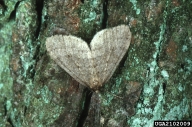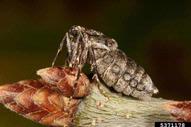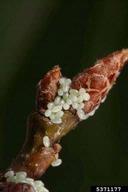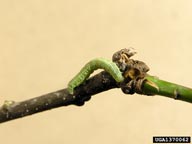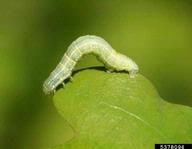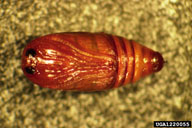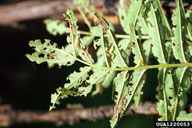Winter moth
Operophtera brumata (L.) (Lepidoptera: Geometridae)
Orientation to pest
Winter moth, Operophtera brumata (L.), is a European geometrid that is invasive in North America, in Nova Scotia, part of British Colombia, and, most recently, southern New England. It is a defoliator that is a generalist feeder, attacking a variety of hardwoods. Winter moths overwinter as eggs, which hatch early in spring, and young larvae feed on opening buds and developing leaves. Older larvae feed inside loose leaf rolls and, when mature, drop to the ground, where they pupate late May to early June. Adults emerge in late fall or early winter. Females, which are wingless, climb trees to lay eggs. Persistent defoliation leads to branch death, top kill, and tree death.
Hosts commonly attacked
This species is a generalist feeder that attacks are variety of hardwoods, but especially apple (Malus), red oak (Quercus rubra L.), American elm (Ulmus americana L.), red maple (Acer rubrum L.), American basswood (Tilia americana L), and hop hornbeam (Ostrya virginiana [Mill.] K. Koch).
Distribution
This geometrid is native in Europe, but in North America invasive populations exist in Nova Scotia, the Pacific Northwest (Oregon to British Columbia) and the northeastern United States. Outbreak populations currently exist in eastern Massachusetts and Rhode Island. A survey with pheromone traps by Elkinton et al. (2010) recovered winter moths mainly in coastal areas from Long Island to Maine.
Images of winter moth
| Figure 1. Adults of winter moth, Operophtera brumata; male (top) and wingless female (bottom) | Figure 2. Eggs of winter moth |
| Figure 4. Pupa of winter moth | |
| Figure 3. Larvae of winter moth | Figure 5. Feeding of larvae of winter moth |
Important biological control agents related to this pest species
This species has well known natural enemies, having been studied in part of its native range (the UK) and been the target of successful classical biological control programs in both eastern and western Canada. Similar work is now underway in Massachusetts. The natural enemies of most importance are the tachinid parasitoid, Cyzenis albicans Fallén, and the ichneumonid Argypon flaveolatum (Gravenhorst). The tachinid is the more important.
Web links for information on winter moth
- Bulletin | UMass Extension
Identification and management guide from Massachusetts Landscape, Nursery, and Urban Forestry Program - Winter Moth Overview | UMass Extension
General information from Massachusetts Landscape, Nursery, and Urban Forestry Program - Wikipedia Article | Wikipedia, the free encyclopedia
- Youtube Video about killing winter moths in Massachusetts | Joe Elkinton of the University of Massachusetts
Articles
- Ring, R. A. 1988. Pest management of the European winter moth, Operophtera brumata (L.), in British Columbia. Northwest Environmental Journal 41: 329-330.
- Embree, D. G. 1991.The winter moth Operophtera brumata in eastern Canada, 1962-1988. Forest Ecology and Management 39: 47-54.
- Elkinton, J. S., G. H. Boettner, M. Sremac, R. Gwiazowski, R. Hunkins, J. Callahan, S. B. Schuefele, C. Donahue, A. H. Porter, A. Khrimian, B. M. Whited, and N. K. Campbell. 2010. Survey for winter moth, (Lepidoptera: Geometridae) in northeastern North America with pheromone-baited traps and hybridization with the native Bruce spanworm. Annals of the Entomological Society of America 103:135-145.
